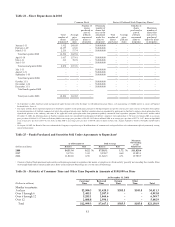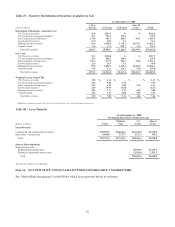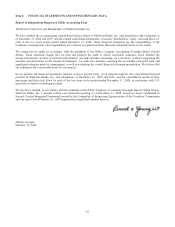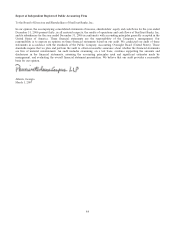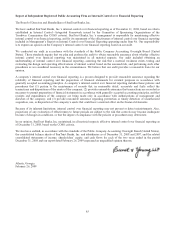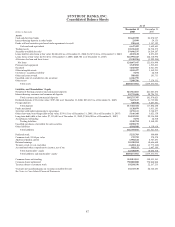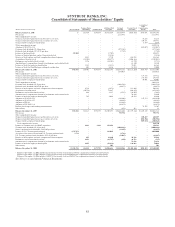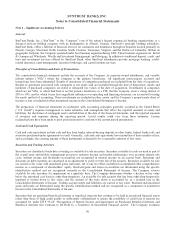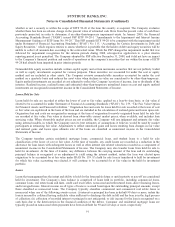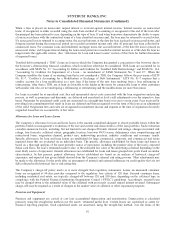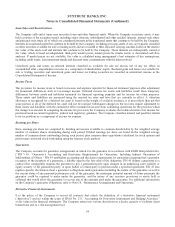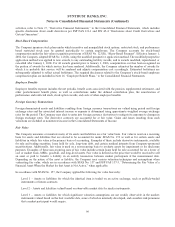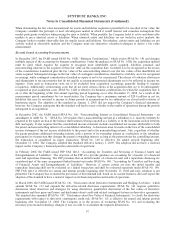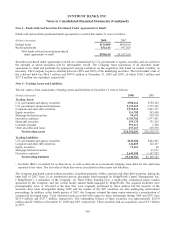SunTrust 2008 Annual Report Download - page 103
Download and view the complete annual report
Please find page 103 of the 2008 SunTrust annual report below. You can navigate through the pages in the report by either clicking on the pages listed below, or by using the keyword search tool below to find specific information within the annual report.SUNTRUST BANKS, INC.
Notes to Consolidated Financial Statements (Continued)
whether or not a security is within the scope of EITF 99-20 at the time the security is acquired. The Company evaluates
whether there has been an adverse change in the present value of estimated cash flows from the present value of cash flows
previously projected, in order to determine if an other-than-temporary impairment exists. In January 2009, the Financial
Accounting Standards Board (“FASB”) issued FSP EITF 99-20-1 “Amendments to the Impairment and Interest Income
Measurement Guidance of EITF Issue No. 99-20.” This FSP amends EITF 99-20 to be consistent with the impairment model
under Statement of Financial Accounting Standards (“SFAS”) No. 115, “Accounting for Certain Investments in Debt and
Equity Securities,” which requires entities to assess whether it is probable that the holder of debt and equity securities will be
unable to collect all amounts due according to the contractual terms. While the FSP changes the impairment model that was
followed for impairment recognition for the interim periods during 2008, retrospective application to a prior interim
reporting period is not permitted. The Company adopted the FSP effective December 31, 2008, and it did not have an impact
to the Company’s financial position and results of operations as the company’s securities that are within the scope of EITF
99-20 had already been impaired in prior interim periods.
Nonmarketable equity securities include venture capital equity and certain mezzanine securities that are not publicly traded
as well as equity investments acquired for various purposes. These securities are accounted for under the cost or equity
method and are included in other assets. The Company reviews nonmarketable securities accounted for under the cost
method on a quarterly basis and reduces the asset value when declines in value are considered to be other-than-temporary.
Equity method investments are recorded at cost adjusted to reflect the Company’s portion of income, loss or dividends of the
investee. Realized income, realized losses and estimated other-than-temporary unrealized losses on cost and equity method
investments are recognized in noninterest income in the Consolidated Statements of Income.
Loans Held for Sale
Loans held for sale are recorded at either the lower of cost or fair value, applied on a loan-by-loan basis, or fair value if
elected to be accounted for under Statement of Financial Accounting Standards (“SFAS”) No. 159, “The Fair Value Option
for Financial Assets and Financial Liabilities.” Origination fees and costs for loans held for sale recorded at the lower of cost
or fair value are capitalized in the basis of the loan and are included in the calculation of realized gains and losses upon sale.
Origination fees and costs are recognized in earnings at the time of origination for newly-originated loans held for sale that
are recorded at fair value. Fair value is derived from observable current market prices, when available, and includes loan
servicing value. When observable market prices are not available, the Company will use judgment and estimate fair value
using internal models, in which the Company uses its best estimates of assumptions it believes would be used by market
participants in estimating fair value. Adjustments to reflect unrealized gains and losses resulting from changes in fair value
and realized gains and losses upon ultimate sale of the loans are classified as noninterest income in the Consolidated
Statements of Income.
The Company transfers certain residential mortgage loans, commercial loans, and student loans to a held for sale
classification at the lower of cost or fair value. At the time of transfer, any credit losses are recorded as a reduction in the
allowance for loan losses with subsequent losses as well as other interest rate related valuations recorded as a component of
noninterest income in the Consolidated Statements of Income. The Company may also transfer loans from held for sale to
held for investment. At the time of transfer, any difference between the carrying amount of the loan and its outstanding
principal balance is recognized as an adjustment to yield using the interest method, unless the loan was elected upon
origination to be accounted for at fair value under SFAS No. 159. If a held for sale loan is transferred to held for investment
for which fair value accounting was elected, it will continue to be accounted for at fair value in the held for investment
portfolio.
Loans
Loans that management has the intent and ability to hold for the foreseeable future or until maturity or pay-off are considered
held for investment. The Company’s loan balance is comprised of loans held in portfolio, including commercial loans,
consumer loans, real estate loans and lines, credit card receivables, nonaccrual and restructured loans, direct financing leases,
and leveraged leases. Interest income on all types of loans is accrued based upon the outstanding principal amounts, except
those classified as nonaccrual loans. The Company typically classifies commercial and commercial real estate loans as
nonaccrual when one of the following events occurs: (i) interest or principal has been in default 90 days or more, unless the
loan is secured by collateral having realizable value sufficient to discharge the debt in full and the loan is in the legal process
of collection; (ii) collection of recorded interest or principal is not anticipated; or (iii) income for the loan is recognized on a
cash basis due to the deterioration in the financial condition of the debtor. Consumer and residential mortgage loans are
typically placed on nonaccrual when payments have been in default for 90 and 120 days or more, respectively.
91


